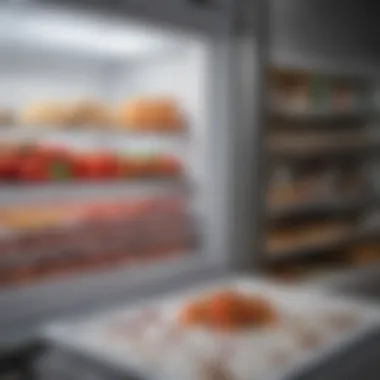Comprehensive Guide to Freezer Ratings and Reviews


Intro
In the realm of culinary endeavors, the freezer stands as a crucial appliance. It plays an essential role in food preservation and meal planning. Understanding freezer ratings and reviews is important for consumers, whether they are casual cooks or professional chefs. This comprehensive guide aims to provide an in-depth look at the factors that influence freezer performance and consumer satisfaction.
With numerous models available, navigating the options can be overwhelming. Ratings often reflect aspects such as energy efficiency, storage capacity, and temperature stability. All these details determine how well a freezer meets the specific needs of each user.
Important metrics are explored throughout this guide, helping potential buyers comprehend how different features affect usability. Industry standards play a significant role as well, ensuring that products meet certain benchmarks in quality. This article will summarize key findings and insights gathered from consumer feedback, leading to more informed purchasing decisions.
In summary, understanding freezer ratings is vital. It allows users to maximize their investment while ensuring food safety and quality. By delving into these ratings, this guide seeks to equip readers with the necessary knowledge for optimal freezer selection and usage.
Understanding Freezer Types
Understanding the different types of freezers is crucial for anyone considering a purchase. Each type offers distinct advantages and features, which can significantly influence user experience and storage efficiency. The choice between a chest freezer, an upright freezer, or a portable freezer hinges on factors such as available space, intended use, and personal preference. A well-informed decision can enhance food preservation methods and streamline kitchen organization.
Chest Freezers
Chest freezers are generally recognized for their spacious interiors and energy efficiency. They hold greater capacity than most upright models, making them suitable for bulk storage. This type of freezer allows users to store large quantities of food without sacrificing space. One significant benefit is the design, which offers better temperature retention during power outages. When you open a chest freezer, the cold air stays trapped, minimizing temperature fluctuations.
However, accessibility can be a drawback. The deep design makes it challenging to organize items, often leading to a situation where food is forgotten at the bottom. Using bins or dividers can help mitigate this issue, but it requires some initial effort.
Upright Freezers
Upright freezers provide a different convenience level, particularly regarding access and organization. With shelves and compartments, users can see all contents at a glance. This type of freezer is generally more compact than chest freezers, making them a practical choice for smaller spaces.
While they are easier to organize, upright freezers tend to use more energy than chest models, partly due to their design. Cold air escapes quickly when the door opens. Nevertheless, many come with features like alarms or automatic defrost, adding utility and convenience. This type suits individuals planning to frequently access different foods or those with limited kitchen space.
Portable Freezers
Portable freezers have gained popularity due to their versatile nature and compact size. These models are generally lightweight and can be used in various settings, including road trips, camping, and outdoor events. They run on standard electricity or battery power, making them extremely adaptable.
The primary downside is their storage capacity, which is more limited compared to chest or upright freezers. This aspect makes them ideal for short-term use or specific occasions rather than as a primary storage solution. Also, they may not offer the same level of insulation as traditional models. Users should assess their needs and usage patterns to determine if a portable freezer meets their requirements.
Key Features to Consider
When evaluating freezers, understanding key features is essential for making an informed choice. This section will address several crucial aspects that impact performance and utility. By grasping these elements, one can select a model that meets specific needs and preferences.
Capacity
Capacity is one of the most significant factors to consider when choosing a freezer. It directly affects how much food one can store. Generally measured in cubic feet, one must select a capacity based on household size and storage requirements. A family of four might need at least 14 to 16 cubic feet for bulk buying, while a single user may find 5 to 8 cubic feet sufficient.
Undersizing can lead to inadequate storage, whereas an oversized freezer may waste energy and space. Therefore, assess your storage habits carefully before deciding.
Energy Efficiency Ratings
Energy efficiency is more critical now than ever, given rising energy costs and environmental concerns. Freezers are rated under guidelines set by organizations, such as ENERGY STAR. These ratings indicate the energy consumption of a model. Choosing an energy-efficient freezer not only saves money on electricity bills but also decreases the carbon footprint.
While it might be tempting to opt for lower-priced models, models with higher energy efficiency ratings typically save more money in the long run despite higher upfront costs. When examining efficiency ratings, also consider how well a model maintains temperature during power outages, as this can impact food quality.
Temperature Control
Effective temperature control is paramount for preserving food quality. A freezer should maintain a consistent temperature ideally around -18°C (0°F). Models come with adjustable thermostats, which allow users to tailor the temperature according to current needs. Look for indicators such as digital displays or alerts that notify when the temperature fluctuates.
Furthermore, some units offer rapid freeze functions, which help quickly freeze items that might otherwise take longer to store properly. This feature can be advantageous for preserving nutrients in fresh produce and maintaining texture in meat and seafood.
Storage Options
Freezers offer various storage options that impact usability. Different models come with features like shelves, bins, and compartments. For example, chest freezers often have more space and are ideal for bulk storage but may lack organization. In contrast, upright freezers typically feature shelves that make accessing items easier.
Here are some considerations for storage options:


- Shelving: Adjustable shelves can be practical for storing taller items.
- Baskets: Baskets or bins can help in keeping smaller items together.
- Door Storage: Some upright models come with door racks for quick access to frequently used items.
These aspects may not seem significant individually, but collectively, they contribute to overall user experience and satisfaction. Selecting a model with appropriate storage options enhances one's efficiency in routine kitchen tasks.
Evaluating Freezer Ratings
Evaluating freezer ratings is critical in making informed decisions about which freezer to purchase. Ratings offer a quantifiable assessment of a product's performance, efficiency, and reliability. They synthesize real-world performance data, user feedback, and expert analysis into a format that is easy to understand. This process allows potential buyers to compare models based on quantifiable metrics rather than subjective perceptions.
Moreover, freezer ratings can impact long-term satisfaction and utility. A highly rated freezer can save energy, reduce operational costs, and maintain the quality of food stored within. On the other hand, overlooking ratings could lead to poor purchases and dissatisfaction. Thus, understanding how to evaluate these ratings is vital for making choices that align with one's needs and priorities.
Consumer Reports and Reviews
Consumer reports and reviews play a significant role in evaluating freezer ratings. These documents are often compiled through rigorous testing and user surveys. They provide insights into various aspects such as freezing capabilities, energy consumption, and ease of use.
When reading consumer reports, it is important to consider:
- Detailed testing methodologies: Understand how the freezer was tested. Different methods can yield varying results.
- User demographics: Sometimes, a review may reflect the experience of a specific group, which might_not accurately represent the general population.
- Volume of reviews: The more reviews available, the more reliable the average rating becomes.
Often, consumer reports highlight potential issues that manufacturers may not openly disclose, making them invaluable in the decision-making process.
Expert Ratings and Recommendations
Expert ratings provide a different perspective on freezer performance than consumer reviews. Experts typically conduct in-depth evaluations using established criteria to assess a freezer’s reliability and efficiency. Their insights can be especially useful for prospective buyers.
Key considerations for expert ratings include:
- Technical Specifications: Experts analyze energy usage, temperature consistency, and overall build quality.
- Longevity and Durability: Many expert reviews will assess how well a freezer lasts over time, which can be crucial for long-term investments.
- Market Trends: Keeping track of industry trends and innovations in technology allows experts to make recommendations based on the latest advancements.
Utilizing expert reviews can guide consumers toward high-quality products that may not be marketed aggressively but perform outstandingly in real-world conditions.
Brand Reputation
Brand reputation is another essential factor in evaluating freezer ratings. Some brands have established strong reputations over decades due to their commitment to quality, customer service, and innovation. When considering a purchase, the manufacturer's history with maintaining sustainable performance can inform expectations regarding efficiency and reliability.
As a consumer, examining brand reputation involves looking at:
- Customer Service Records: Are issues quickly resolved? Good customer service enhances the overall ownership experience.
- Longevity in the Market: Brands that have stood the test of time often have proven products.
- Active Engagement with Users: Brands that communicate well with their consumers tend to improve their products based on feedback.
In summary, assessing brand reputation can further refine your options and ensure you invest in a well-regarded product. By taking consumer reports, expert ratings, and brand reputation into account, you can confidently navigate the market and make an informed freezer choice.
Comparative Analysis of Popular Brands
Understanding the comparative landscape of popular freezer brands is crucial for anyone considering an investment in a freezer. With many options available, shoppers can benefit from distinguishing features, functional specifications, and overall consumer perceptions associated with these brands. Analyzing brand performance helps demystify the complex array of features and functions that different models offer. Furthermore, knowing the strengths and weaknesses of each brand allows consumers to align their choices with personal needs and preferences. The comparative analysis also provides insights into reliability, durability, and customer service, key factors that often influence purchasing decisions.
Brand A Overview
Brand A is well-regarded in the freezer market for its innovative designs and robust features. One of the notable aspects of Brand A's freezers is their energy efficiency, often rated highly. Many users appreciate the reliable temperature maintenance, which keeps food preserved effectively.
In terms of customer feedback, Brand A receives a fair amount of positive testimonials, particularly praising their user-friendly controls and spacious interiors. Customers also highlight the quiet operation of these models, making them suitable for residential environments. However, some users have mentioned that the initial price point can be on the higher side compared to competitors, which might be a consideration for budget-conscious buyers.
Brand B Overview
Brand B brings a balanced mix of affordability and reliable performance. This brand is known for offering models that cater to different needs, from compact upright freezers to larger chest options. Brand B often highlights its commitment to energy efficiency, appealing to consumers concerned about electricity costs.


Users have indicated satisfaction with Brand B's durability and warranty support, which can potentially extend the lifespan of the appliance. The versatile shelving arrangements in Brand B’s freezers have earned accolades for making organization easier, allowing better access to stored items. Still, while generally reliable, there have been a few reports of inconsistency in temperature control among older models, which might warrant closer inspection when considering a purchase.
Brand Overview
Brand C is synonymous with high performance and cutting-edge technology. This brand tends to focus on premium features, such as advanced temperature controls and smart home integration capabilities. These features appeal to tech-savvy consumers who wish to monitor their freezer remotely.
Brand C’s freezers are often praised for their spacious interiors, maximizing storage potential without compromising energy efficiency. While there are numerous positive reviews regarding user experience, some have pointed out that models can be quite expensive. Thus, potential buyers might weigh the enhanced features against the significantly higher investment.
"Investing in a freezer from a reputable brand can save you money in the long run through energy efficiency and reliable performance."
In summary, analyzing these brands helps consumers evaluate not just the upfront costs but also long-term value from energy savings and product longevity.
User Experiences and Testimonials
User experiences and testimonials play a crucial role in the discussion of freezers. They provide real-world insight that surpasses technical specifications and ratings. Potential buyers often seek authentic feedback from individuals who have directly interacted with specific freezer models. This section delves into why these accounts matter and what elements they highlight.
First, personal testimonies give depth to the theoretical understanding of freezer performance. While ratings often focus on aspects like energy efficiency, temperatures maintained, and storage capabilities, user feedback discusses practical implications. For instance, comments on usability, noise levels, and ease of cleaning help buyers form a more comprehensive picture. Moreover, users report their experiences over time, providing data that can inform others about durability and performance consistency.
Additionally, this kind of information aids consumers in recognizing patterns in product performance. Users may share how long their freezer maintains temperature during power outages or how well it stores different types of food. This kind of data proves invaluable as it bridges the gap between specifications and actual usage scenarios, leading to informed decisions.
"User reviews reveal the long-term reliability of a freezer, unlike short-lived expert tests."
The nuances in feedback allow potential buyers to evaluate which features matter most to them. For example, when a user mentions that a particular freezer model has ample compartments for organization, it strikes a chord for someone who values organization. Likewise, negative feedback may warn others about issues that could impact their daily convenience or efficiency.
Positive Feedback
When exploring user experiences, positive feedback often highlights the strength of a freezer model. Buyers frequently express satisfaction regarding several core aspects. Features that generate the most praise include:
- Energy Efficiency: Many users rave about their unit’s low energy consumption. Positive testimonials often relate how the freezers not only save money on electricity bills but also perform efficiently without frequent cycling.
- Capacity and Organization: Ample storage space and user-friendly layouts are frequently mentioned. Testimonials often detail how various compartments help in organizing food, making it easy to access items without digging around.
- Temperature Consistency: Users appreciate models that maintain stable temperatures across varying conditions. Many reviews confirm that certain brands quickly cool down items and keep them frozen well even under frequent door openings.
Such accounts help prospective buyers feel more secure in their choices, knowing that others have had success with the product.
Common Complaints
On the flip side, common complaints can also reveal significant insights that affect potential purchases. Users will often turn to forums and consumer feedback sections to voice their displeasure about various issues. Noteworthy complaints may include:
- Noise Levels: Some users report that their freezers operate at levels higher than expected. Noise can be a crucial factor for those who prefer quiet appliances, especially in open-plan living spaces.
- Defrost Issues: A recurring complaint centers around models that ice up quickly or require frequent defrosting. This issue can cause frustration and higher maintenance needs.
- Temperature Fluctuations: Certain models may struggle to maintain consistent temperatures, leading to concerns about food safety and quality.
Complaints often prompt buyers to do more research before committing to a purchase. They encourage questioning the effectiveness of advertised features against actual performance.
Price Range Analysis
Understanding the price range of freezers is crucial when making a purchase decision. Different models and brands come with varying price points, reflecting their features, capacity, and energy efficiency. This section explores key elements associated with freezer pricing, the benefits of each range, and considerations for buyers. Knowing where a freezer falls on this spectrum can guide consumers in selecting options that meet their needs without overspending.
Budget Options
Budget options in the freezer market generally cater to those with limited financial flexibility. These models often range below a specific price threshold, making them accessible to a wider audience. These freezers typically have basic features and smaller capacities. However, they can serve essential functions for those who need to store regular food items or make the most of limited space.
Key considerations for budget options include:
- Size and capacity: Smaller models are preferred for those with limited kitchen space or lower storage needs.
- Efficiency: Many budget freezers may not be the most energy-efficient, which can lead to higher utility bills over time.
- Reliability: Some budget options may lack durability, impacting their long-term viability.
Budget models can still deliver reasonable performance, appealing to consumers looking for simplicity without lavish features.


Mid-Range Models
Mid-range models strike a balance between price and performance. These freezers typically come with enhanced features compared to budget options. They may offer slightly larger capacities, better energy efficiency ratings, and additional functionalities like adjustable shelving or temperature controls.
Advantages of mid-range models include:
- Versatility: These models often cater to a wider variety of storage needs, making them suitable for families or individuals with diverse food storage requirements.
- Energy efficiency: Many mid-range options have better ratings, reducing energy consumption compared to cheaper counterparts.
- Enhanced features: Consumers may find features such as digital displays or internal lighting that better facilitate food organization and monitoring.
For those ready to invest a bit more, mid-range options provide a quality balance that aligns well with both performance expectations and budget considerations.
High-End Freezers
High-end freezers represent the top tier of the market, often characterized by exceptional quality, advanced technology, and notable energy efficiency. These models can cater to culinary enthusiasts or professional chefs who demand optimal performance.
When examining high-end freezers, some key attributes are:
- Superior energy efficiency: Higher upfront costs can translate into savings on energy bills due to advanced insulation and compressor technologies.
- Large capacities and customizable options: These models often offer spacious interiors along with customizable shelving and compartments, enhancing storage flexibility.
- Smart technology features: Many high-end units come equipped with smart technology, allowing for real-time monitoring and adjustments via mobile applications.
For consumers who prioritize quality and performance and are willing to invest significantly, high-end freezers offer a premium storage solution that can enhance the culinary experience.
In summary, understanding the price range of freezers is essential for making an informed decision that aligns with individual requirements and financial capabilities.
Maintenance and Care Tips
Proper maintenance and care of your freezer is essential to ensure optimal performance and longevity. Routine checks can prevent malfunctions, maximize energy efficiency, and enhance food preservation. When a freezer is well-maintained, it operates more effectively, reducing waste and cost over time. Overlooking this aspect can lead to more significant issues in the long run, which may require costly repairs or replacements.
Routine Cleaning
Keeping your freezer clean can significantly improve its efficiency and functionality. Regular cleaning is not just about aesthetics; it also contributes to healthier food storage.
- Defrost Regularly: If you own a manual defrost freezer, it’s key to remove ice buildup. Excess ice can hinder performance by reducing available storage space and increasing energy consumption.
- Wipe Down Surfaces: Use a mixture of water and mild detergent to regularly wipe down interior surfaces. This will not only remove spills and stains but also help eliminate odors that can accumulate over time.
- Check Seals: Inspect the door seals for wear and tear. Proper sealing keeps cold air from escaping. If you notice any damage, it could cause increased energy bills.
- Keep it Organized: A tidy freezer allows for quicker access to items, reducing the time the door is open and thereby maintaining temperature stability. Use bins and labels to categorize food.
Common Troubleshooting
Having a basic understanding of troubleshooting can save both time and money. Many issues can be resolved without professional help.
- Freezer Not Cooling: Check the temperature settings first. If settings are correct, it may be an issue with the compressor or the thermostat.
- Excessive Frost Build-Up: This could indicate a faulty door seal. Ensure that the door closes properly and that no warm air is entering. If frosted, defrost the unit.
- Unusual Noises: If you hear strange sounds, it could be due to blocked vents or a failing fan. Examine the internal layout; ensure nothing is obstructing airflow.
- Leakage: Excessive condensation can lead to pooling water. Inspect the drainage system, ensuring it is not clogged.
Regular maintenance and care can extend the life of your freezer substantially, ensuring your investment pays off in the long run.
In summary, maintaining a freezer requires a combination of routine cleaning, checking for common issues, and ensuring that everything is functioning properly. These simple steps help in maximizing the efficient use and lifespan of your appliance.
Culmination: Making an Informed Decision
Making an informed decision when purchasing a freezer is crucial for maximizing value and efficiency. Understanding the complexities of freezer ratings and reviews helps consumers navigate their options. This section synthesizes the key points discussed throughout the guide. It emphasizes the importance of evaluating the features that align with individual needs.
A well-considered choice in freezers ensures not only optimal food preservation but also energy savings over time. An informed buyer is more likely to find a model that fits their needs while avoiding unnecessary expenses. Freezer ratings and consumer feedback play a significant role in this assessment, as they provide insights on performance and reliability.
Summarizing Key Takeaways
- Types of Freezers: Each type—chest, upright, and portable—serves distinct purposes. It's essential to match the type with storage and accessibility needs.
- Features Matter: Elements like capacity, energy efficiency, and temperature control significantly impact performance.
- Consumer Ratings: Reviews from both casual users and expert evaluators guide decisions. Brand reputation can influence product reliability.
- Pricing Insights: A budget-friendly model might meet basic needs, while premium options could offer advanced features for serious culinary enthusiasts.
"Knowledge is power when it comes to making appliance decisions. Evaluating ratings gives you that power."
Final Recommendations
When choosing a freezer, consider the following recommendations:
- Assess Your Needs: Reflect on how you plan to use the freezer. Will you store large quantities of food, or are you looking for occasional use?
- Prioritize Energy Efficiency: Select models with high energy efficiency ratings to save on bills.
- Explore User Feedback: Read consumer reviews carefully, focusing on details that match your priorities, such as noise levels or durability.
- Consider Maintenance Needs: Choose a model that you can easily maintain and repair. Research common issues reported by other users.
- Invest Wisely: If budget allows, investing in a high-end model may yield longer-term benefits and satisfaction.
By applying these insights, one can navigate the market of freezers effectively. Armed with this knowledge, the path to a reliable and efficient freezer becomes clearer, meeting both culinary ambitions and everyday needs.







